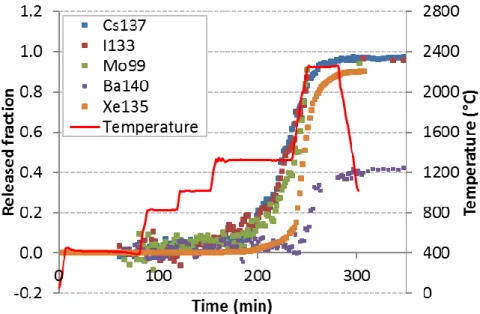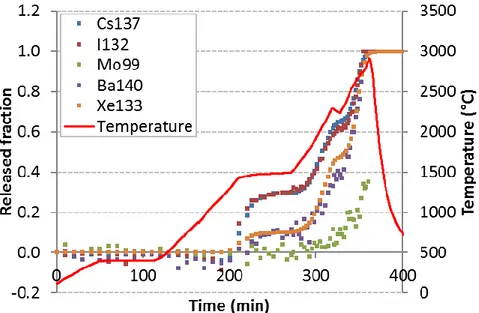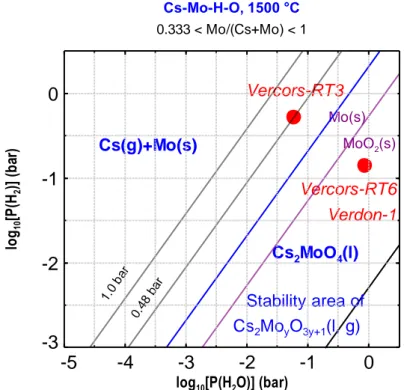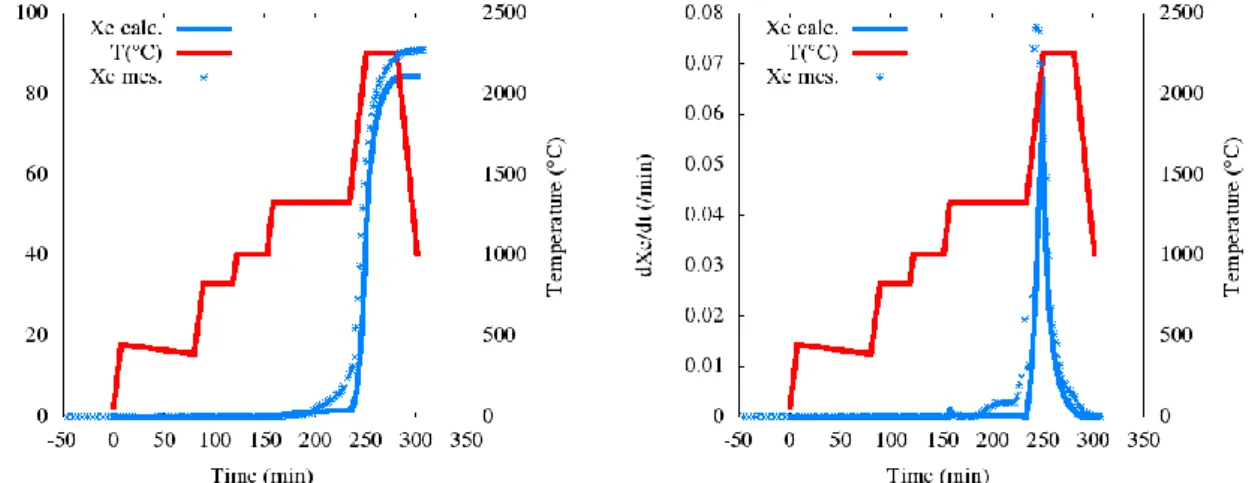HAL Id: cea-02400191
https://hal-cea.archives-ouvertes.fr/cea-02400191
Submitted on 9 Dec 2019HAL is a multi-disciplinary open access archive for the deposit and dissemination of sci-entific research documents, whether they are pub-lished or not. The documents may come from teaching and research institutions in France or abroad, or from public or private research centers.
L’archive ouverte pluridisciplinaire HAL, est destinée au dépôt et à la diffusion de documents scientifiques de niveau recherche, publiés ou non, émanant des établissements d’enseignement et de recherche français ou étrangers, des laboratoires publics ou privés.
Speciation and release kinetics of the fission products
Mo, Cs, Ba and I from nuclear fuels in severe accident
conditions
Ch. Riglet-Martial, J. Sercombe, Yves Pontillon
To cite this version:
Ch. Riglet-Martial, J. Sercombe, Yves Pontillon. Speciation and release kinetics of the fission products Mo, Cs, Ba and I from nuclear fuels in severe accident conditions. WRFPM 2018, Sep 2018, Prague, Czech Republic. �cea-02400191�
SPECIATION AND RELEASE KINETICS OF THE FISSION
PRODUCTS Mo, Cs, Ba and I FROM NUCLEAR FUELS IN SEVERE
ACCIDENT CONDITIONS
Ch. RIGLET-MARTIAL, J. SERCOMBE, Y. PONTILLON
CEA, DEN, DEC – Centre de Cadarache 13108 Saint-Paul-lez-Durance - France
ABSTRACT
A speciation and release kinetics study of the gaseous fission products freed from nuclear fuels in conditions of severe accident (temperature range 1300°C – 2500°C) as a function of the applied thermodynamic conditions is carried out using the experimental feedback collected at CEA within the VERCORS and VERDON programs.
The nature of the major species involved are deduced from the analysis of the specific features of the Cs-Mo-Ba-I-O chemical system in the composition range of irradiated nuclear fuels. Stable gaseous Cs and Ba molybdate species, i.e. and , clearly predominates in oxidising conditions, which contributes to increase significantly the released fraction of molybdenum as compared to reducing conditions.
An analytical model accounting for thermo-chemistry in the release rate of chemically reactive elements is applied to estimate the release of Cs, I, Mo and Ba in severe accident conditions. Good agreement is achieved with on-line measurements.
1.
Introduction
Thermodynamic equilibrium modelling is a powerful tool for the description of complex chemical processes and systems, like those involved in irradiated nuclear fuels. A special case of great current interest in this field is the assessment of the possible consequences of severe reactor accidents. The major concern is to determine the Source Term, i.e. the speciation, release rate and global released fraction of the fission products (FP) and other radioactive materials.
Temperature and oxygen partial pressure (i.e. oxygen potential) are the major parameters governing the speciation and release behavior of the fission products from nuclear oxide fuels. In severe accident conditions, temperature significantly exceeds the nominal one and strong variations of oxygen potential are likely to occur because of oxidation of the Zr-clad by water (giving large amount of H2) followed by ingress of steam or air. Major variations in the
speciation and release of volatile fission products are thus expected in such off-normal conditions.
A large number of research programs in the field of severe reactor accidents have been undertaken in various countries, in order to assess the Source Term. Some of them like PHEBUS-FP are devoted to integral tests while others are devoted to separate-effect experiments1. Among the later, the VERCORS and VERDON programs are composed of a series of analytical tests conducted on samples of irradiated PWR fuels, in carefully controlled temperature and oxido-reduction conditions. From those thermal tests carried out in highly instrumented experimental facilities, extensive and invaluable data were collected and then used to improve the models for the Source Term evaluation.
Among the chemical systems arising from fission products in irradiated oxide fuels, the Cs-Mo-O system is one of the most important in assessing the consequences of off-normal operating conditions. In calculation of fission products (FP) releases from irradiated fuels2, Cs
1
Y. Pontillon et al., Nuclear Engineering and Design, 2010, 240-7, 1843-1852 ;1853-1866 ;1867-1881 Journal of Nuclear Materials, 2017, 495, 49-57 ; 291-298 ; 363-384
2
is usually found to be freed from the reactor core as , and , while Mo is freed as and , 0<x<3. However, discrepancies between experimental and calculated released fractions still remain, possibly owing to limitations in the thermodynamic database. In fact, in view of recent specific studies performed on the Mo-Cs-I-O-H system in conditions representative of severe accidents, it is highly suspected that caesium polymolybdates should contribute significantly to the Mo and Cs releases from irradiated fuels3. Thus, complementary to basic investigations on the thermodynamics of caesium mono-molybdate , the high temperature behaviour of higher molybdates such as has been studied in details recently3.
The present paper is devoted to a speciation and release kinetics study of the gaseous fission products freed from nuclear fuel in conditions of severe accident (temperature range 1300°C – 2500°C), as a function of the applied thermodynamic conditions. The analysis relies on the experimental feedback collected at CEA within the VERCORS and VERDON programs. At first, the nature of the major chemical species involved are deduced from the analysis of the specific features of the Cs-Mo-I Ba-O chemical system in the composition range of irradiated nuclear fuels, as reflected by the experimental released fractions curves. Then, an analytical model accounting for thermo-chemistry in the release rate of chemically reactive elements is outlined and applied to FP releases in severe accident conditions.
2.
Thermochemical characteristics of the VERCORS and VERDON tests
The thermal treatment tests performed within the VERCORS and VERDON programs aim at quantifying the release of fission products (FP) and actinides from irradiated nuclear ceramics during a severe accident. From 1989 onwards, extensive and invaluable data were collected about i) the released fraction and release rates of FPs from irradiated fuels ii) the nature and chemical composition of the vapours and aerosols emitted and iii) the degradation mechanisms of the fuel.Full descriptions of the experimental set-ups and detailed analyses of the data collected in various temperature and redox conditions are given in reference 1 (and related references). To summarize, the fuel samples are composed of PWR sections containing three UO2 pellets in their original zircaloy cladding. Before thermal
testing, the samples are generally re-irradiated at low power in order to rebuild the inventory of short-lived fission products. Then, the experimental sequence consists in applying first a temperature plateau (at 1300°C or 1500°C) under controlled oxygen potential (steam, H2/H2O mixture or H2) in order to fully oxidize the cladding. Then a temperature ramp is
applied (with occasionally intermediate temperature plateaus) under controlled oxido-reduction conditions (steam, H2/H2O mixture or H2) until the sample collapses.
The present study refers specifically to the VERCORS-5, -RT3, -RT6 and VERDON-1 tests. All relevant information and data for the current analysis, taken out from reference 1, are collected in Table 1. The released fraction curves for Cs, Mo, Ba and I for each test under consideration are shown in Figures 1 to 4. Figure 5 gives the thermodynamical characteristics (temperature, oxygen potential) of the tests listed in Table 1, in consistency with the thermohydraulic sequences followed during the experiments. Thus, the set of thermal tests selected in this study covers a range of redox conditions varying from highly reducing (under hydrogen atmosphere) to highly oxidising (under steam atmosphere). The oxidation step until the first temperature plateau (at 1300°C or 1500°C) is carried out for VERDON-1, VERCORS-5 and VERCORS-RT6 in redox conditions slightly higher than that of the (MoO2/Mo) redox buffer, which is assumed to fix the oxygen potential of the fuel in
nominal operating conditions (-380 kJ/mol O2 at ~1000°C). It is clear from Figure 5 that
VERCORS-5, VERCORS-RT6 and VERDON-1 are submitted to similar conditions during the oxidation step up to the first temperature plateau (at 1300°C ou 1500°C). In contrast, during the high temperature step, the VERCORS-5 test is carried out under highly oxidising conditions (steam), while the VERCORS-RT6 test is carried out under the same H2O/H2
Annals of Nuclear Energy, 2013, 61, 88-95
3
Thi Mai Dung Do et al., Journal of Nuclear Science Technology, 2017, 54 :3, 330-336 ; 2018, 55 :3, 348-355
atmosphere as that used for the oxidation step and the VERDON-1 test is carried out under highly reducing conditions similar to that of VERCORS-RT3.
Test reference Fuel Burn-up Atmosphere composition Experimental sequence GWj/tU H2O g/min H2 g/min He g/min
VERCORS-5 38.3 1.5 0.027 0 - Ramp from 400°C to 800°C - 30 min. plateau at 800°C - Ramp from 800°C to 1000°C - 30 min. plateau at 1000°C - Ramp from 1000°C to 1300°C - 70 min. plateau at 1300°C Steam - Ramp from 1300°C to
2300°C
VERCORS-RT6 71.8 1.5 0.027 0 - Ramp from 400°C to 1500°C - 1h plateau at 1500°C
- Ramp from 1500°C to 2200°C
- 30 min. plateau at 2300°C
VERDON-1 72.0 1.5 0.027 0 - Ramp from 400°C to 1500°C
- 1h plateau at 1500°C 0.018 0.020 0.24 - Ramp from 1500°C to
2400°C
VERCORS-RT3 39.0 0.075 0.075 0.12 - Ramp from 400°C to 1500°C - 1h plateau at 1500°C
- Ramp from 1500°C to 2200°C
Tab. 1: Thermohydraulic experimental conditions of the thermal treatment tests under consideration in the current speciation study (Figs.1 to 5). The data come from reference1.
The released fraction data of Cs, Mo and I from the fuel samples of varying burn up in varying experimental conditions exhibit a number of typical features indicative of the speciation of the gaseous species involved in the process, as described below.
- In oxidising conditions (VERCORS-5, -RT6 and VERDON-1), caesium and molybdenum are released together from about 1200°C onward, which suggests that Cs and Mo are very likely involved into mixed chemical species of type ; - Up to the oxidation plateau at 1500°C, the VERCORS-RT6 and VERDON-1 samples
are submitted to similar oxidising redox conditions and they both show similar released fraction curves for Cs and Mo with a ratio %Mo/%Cs ~ 2/3;
- In highly oxidising conditions (VERCORS-5), Ba releases partially together with Cs and Mo, which would be consistent with the presence of both mixed caesium-molybdenum and barium caesium-molybdenum species. The later would thus contribute to further increase the release of molybdenum as compared to less oxidising conditions; - The VERCORS-RT3 sample and the VERDON-1 sample (in the high temperature
Cs, Mo and Ba are released independently in those redox conditions, which indicates that the mixed Cs-Mo species encountered in the VERCORS RT6 and VERDON-1 (at 1500°C) tests as well as the Ba-Mo species encountered in the VERCORS-5 test in oxidising conditions are not stable any more when the oxygen potential is strongly decreased;
Fig 1. FP release kinetics during the VERCORS-5 test
Fig 3. FP release kinetics during the VERDON 1 test
- Above 1300°C, the released fraction curves of iodine and caesium evolves in parallel with time regardless the experimental conditions (burn-up, temperature, redox). The ratio of the released iodine fraction over that of caesium (%I/%Cs) is invariant and close to 1.0. This peculiar feature of the release curves of Cs and I is typical of the simultaneous release of Cs, Mo and I.
In the following section, a simplified thermodynamic speciation scheme is developed in consistency with the characteristics of the experimental FP release curves of the selected thermal tests, assuming thermodynamic equilibrium is achieved between the most likely major species.
Fig 5. Thermochemical characteristics (temperature, oxygen potential) of the thermal tests listed in Table 1
The coloured discs indicate the temperature plateaux (with their duration) during the experimental sequences. All the necessary data for the thermodynamic calculations are taken from reference 5.
3.
Theoretical considerations
3.1.
Cs-Mo-I equilibria in gaseous phase
Let us consider, in consistency with the experimental observations, a gaseous chemical system composed of the two species and released from an irradiated UO2 fuel.
At the instant t, the released quantities of the elements Cs, Mo and I can be written:
(1)
(2)
(3)
The simultaneous releases of Cs, Mo and I are then linked by the relation:
(4)
with , and
In terms of released fractions, equation (4) reads:
(5)
The released fractions of Mo and I as compared to that of Cs are therefore linked by the relation: (6)
The quantities Motot, Cstot and Itot vary with the burn-up. However, in the range 0 - 90 GWj/t U,
by a linear function4. Consequently, the ratios (Motot/Cstot) and (Itot/Cstot) may be considered
constant and independent of burn-up in the range 0 - 90 GWj/t U.
Then, by assuming that no significant loss of Cs, Mo and I occurs prior to the thermal treatment test, the following equalities apply4 in the range 0 - 90 GWj/t U:
;
(7)
Combination of the relations (6) and (7) gives: (8)
As Cs is involved into two different chemical species including Mo and I, the released fractions of Mo, Cs and I are not independent. In fact, the released fractions of both Mo and I as compared to that of Cs are linked by the relation (8) which only depends on the stoichiometric coefficients x and y of the species . The experimental feedback of the VERCORS and VERDON-1 tests shows that the ratio %I(t)/%Cs(t) is invariant and close to 1.0 in most tests, irrespective of the redox and temperature conditions. Considering in equation (8) gives: (9)
In view of recent published studies, it is essential when nuclear fuels are overheated in oxidising conditions to consider the incidence of gaseous caesium polymolybdates, of general formulae , in which Cs and Mo are involved at the oxidation state +I and +VI respectively. Thus, in considering x = 2, which is typical of the stoichiometry of all caesium molybdate species, equation (9) becomes: (10)
Applying equation (10) to the VERDON-1 or VERCORS-RT6 tests for which the ratio %Mo/%Cs is estimated to ~2/3 at 1500°C gives y = 2, which matches with the caesium dimolybdate species . It is therefore concluded in consistency with the experimental observations, that the most likely Cs species released at about 1500°C and around -250 kJ/mol O2 is the caesium dimolybdate . This finding is fully consistent with recently published partitioning calculations of Cs and Mo in gaseous phase in severe accident conditions, which predict the presence in significant amount of in mid-oxidising and moderately high temperature conditions3.
3.2.
Ba-Mo equilibria in gaseous phase
In strongly oxidising conditions such as in VERCORS-5 test, the occurrence of mixed barium-molybdenum species in addition to caesium-molybdenum species could be responsible for the rise of the Mo release as compared to less oxidising redox conditions. Thus, by assuming that Cs and I are involved into the sole species and , and that Ba is involved into a single species of type , the total released quantities of Cs, Mo, Ba and I at the end of the test (instant ) can be written as: (11)(12)
(13)
(14)
which gives, in terms of released fractions: (15) 4
If no significant loss of Cs, Mo Ba and I occurs prior to the thermal treatment test, the following equalities apply4 in the range 0 - 90 GWj/t U:
; ; (16)
Combination of relations (15) and (16) gives: (17)
In the VERCORS-5 test, the experimental release curves of Cs, Mo, Ba and I provide1 %Mo( ) ≈ %Cs( ) ≈ %I( ) ≈ 1 and %Ba( ) ≈ 0.55. Inserting these data in equation (17) gives then y/x ≈ 1.0, which is fully consistent with the mixed Ba-Mo species of stoichiometry , as thermodynamically expected (Fig. 5).
It is thus concluded in consistency with the experimental observations, that Ba is most likely released at high temperature and in highly oxidising conditions under the main species . Note that Ba is partially released under during the test, the remaining part being most likely immobilized into the condensed phase .
4.
Simplified speciation model for Mo, Cs and Ba in severe accident
conditions
The major gaseous species for Mo, Cs and Ba occurring in the thermal tests considered in the present study are summarised in Figures 5 and 6, at 1500 and 2200°C as a function of oxydo-reduction conditions, described with the H2 and H2O partial pressures. The
predominance diagrams are built using the FACTSAGE thermochemical software version 7.2 with the SGPS-SGTE thermodynamic database5. The figures clearly illustrate the high sensitivity to redox conditions of the gaseous species of Mo and Ba in the composition range of irradiated fuels in severe accident conditions.
Fig 6. Predominance diagram of the system Cs-Mo-O-H at 1500°C in the composition range of an irradiated fuel
The red discs refer to the thermodynamic conditions of the thermal tests VERCORS-RT3, -RT6 and VERDON-1 at the oxidation step level.
5
C.W. Bale et al., Calphad, 2016, 54, 35-53
Cs(g)+Mo(s) Vercors-RT6 Vercors-RT3 Verdon-1 1.0 bar 0.48 bar Mo(s) MoO2(s) Cs2MoO4(l) Stability area of Cs2MoyO3y+1(l, g) Cs-Mo-H-O, 1500 °C 0.333 < Mo/(Cs+Mo) < 1
log10[P(H2O)] (bar)
lo g10 [P (H2 )] (b ar)
-5
-4
-3
-2
-1
0
-3
-2
-1
0
Fig 7. Predominance diagram of the gaseous species of the system Zr-Ba-H-O-Mo at 2200°C in the composition range of an irradiated fuel
The red discs refer to the thermodynamic conditions of the thermal tests VERCORS-4, -5, -RT3, -RT6 and VERDON-1 tests, at end of the high temperature step.
The main species involved during the thermal sequences for each test are reported in Fig. 5 and 6. The predicted speciation of Cs, Mo and Ba as well as the partitioning of Mo in the gas phase as a function of redox conditions are consistent with the corresponding experimental release curves.
The most striking feature is the predominance of gaseous polymolybdate species of Cs and Ba in oxidising conditions, which contributes to increase significantly the amount of Mo in gaseous form, as compared to reducing conditions. The main species involved are the caesium dimolybdate and the barium molybdate , which are stabilised from mid-oxidising to highly oxidising conditions.
5.
Release kinetics
To illustrate the consistency of the proposed speciation, it is necessary first to describe the rare gas release kinetics (Xe, Kr). The simplest model that can be adopted for post-irradiation annealing experiments at high temperatures is the equivalent sphere model6. It relates rare gas release to solid-state diffusion of gas atoms in an equivalent spherical fuel grain. One of the limitation of this model is related to the lack of description of trapping sites that form in irradiated fuels7, such as bubbles, pores, dislocations, grain boundaries… One of the main feature of the VERCORS tests series is the dependency of fission gas release on annealing temperature (i.e. 10 to 20% at a temperature plateau of 1300-1500°C in the VERCORS-2, -4 and -5 tests, 45% at a temperature plateau of 1800°C in VERCORS-1 2 tests, and 80 to 90% at a temperature plateau of 2200-2300°C in VERCORS-3,-4
6
Booth, A.H., (1957). A method of calculating fission gas diffusion from UO2 fuel and its application to
the X2 loop test, AECL report 496.
7
Olander D.R., (1976). Fundamental aspects of nuclear reactor fuel elements, Chapter 15, Fission-Gas Release, University of California, Berkeley, ISBN – 0-87079-031-5.
BaHO(g) Ba 2 O(g ) BaO(g ) BaH2O2(g) BaMoO4(g) Ba(g) Vercors-RT6 Vercors-5 Vercors-RT3 Verdon-1 Mo(s) MoO2(s) Zr-Ba-H-O-Mo, 2200 °C 0 < Ba/(Zr+Ba) < 0.5, Mo(s) or MoO2(s)
log10(P(H2O)) (bar)
lo g10 (P (H2 )) (b ar)
-5
-4
-3
-2
-1
0
-3
-2
-1
0
5 tests). Progressive liberation of trapped gas with temperature can explain these observations and should be taken into account in the equivalent sphere model. To this end, it was assumed that the gas available for diffusion increased with temperature according to a linear regression based on the VERCORS tests results. The equivalent sphere model with a temperature-dependent source term was thus solved numerically by a finite volume scheme. Application to Xe release and Xe release kinetics during the VERCORS-5 test is shown in Figure 7. The diffusion coefficient is obtained from the analytical solution of the Booth model considering a FGR of 10% in 20 minutes at 1300°C, a fuel grain radius of 5 µm and the activation energy proposed by Booth. The fit compares well with measurements except at the beginning of the 1300°C plateau where a burst release related to grain boundary gas is observed1
Fig 7. Calculated and measured Xe release and release rate during the VERCORS-5 test Calculating at each time step the release rate of the bulk of fission gases (Xe, Kr), the following approach has been considered for the other (minor) gas species:
- during the 1300°C temperature plateau, all Cs, Mo and I are gaseous and released as and , see equations 1-3;
- at higher temperature and during the 2250°C final plateau, all remaining Cs, Mo and I are again gaseous and released as , , and The quantity of Ba in the gas phase is limited by the availability of Mo and thus given by equations 11-14.
At each time step, the instantaneous released fraction of Xe is applied to the remaining quantities of Cs, Mo, I and Ba associated in the proposed gas species. In consistency with a previous work developed for Pellet-Clad-Interaction (PCI) analysis4, this approach accounts therefore for thermo-chemistry in the release rate of chemically reactive elements (Cs, I, Mo and Ba). Note that there is only one single diffusion equation describing the release of rare gases (Xe). The calculated releases of Cs, I, Mo and Ba during the VERCORS-5 test agree well with on-line measurements, as shown in Figure 8.
Fig 8. Calculated and measured Cs, Mo, I and Ba releases during the VERCORS-5 test
6.
Conclusion
Speciation and release of fission products during the VERCORS and VERDON tests have been discussed. Mass balance calculations carried out from the experimental FP released fractions curves confirmed, in agreement with recently published findings, that gaseous polymolybdate species of Cs and Ba are predominantly formed from mid-oxidising to highly oxidising conditions, in the range 1300°C-2500°C. Release kinetics of those volatile (minor) FP can therefore be highly dependent on surrounding oxydo-reduction conditions. Good agreement was achieved between measured and calculated releases of Cs, I, Mo and Ba during the VERCORS-5 test using an analytical model including the proposed FP thermochemistry and describing diffusion of rare gases only, which illustrate the global consistency of the proposed approach.







